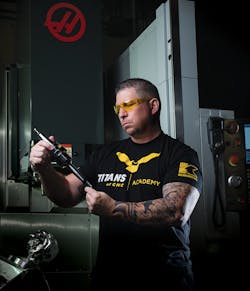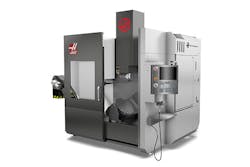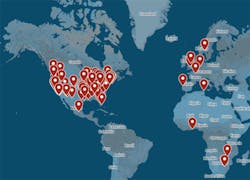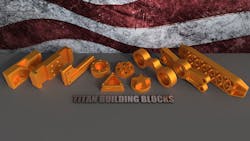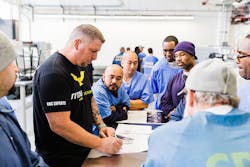The list of obstacles standing in the way of an American manufacturing comeback seems to grow every day. We have the skills gap, robots and AI that someday soon could make human jobs obsolete, and of course, global competition. That last one is perhaps the most daunting, especially if you're a machinist. Consider that many of the parts you make, China does, too, but at a higher volume and for less money.
That's the situation. Now, if American manufacturers think this means we're doomed, then we are. But if we see this as a fight, and one we can win, then we might just have a puncher's chance.
But first, we have to improve our odds.
If you're gearing up for a real fight, that's done by finding the best possible trainer, someone who will push you to your limits and make you work harder than you ever have. As luck would have it, the manufacturing gods have given us a Titan. Titan Gilroy, to be exact.
Gilroy is possibly the perfect (and certainly the toughest) person to lead this charge. Once a rising star in the boxing world who fell from grace and into prison, he's a man who seems to know everything there is about fighting and comebacks. And most importantly, he's a machining virtuoso, able to work a CNC machine like Hendrix did a Stratocaster.
Heavyweight Competition
Along with massive biceps and several tattoos, Gilroy carries with him incredible insights into what it takes to win. That's probably because he's had so much experience with defeat. Abandoned, homeless, bullied, imprisoned. And that was before he turned 25. He has also felt the stinging pain of laying off 40 employees and nearly losing everything. The bulky machine shop owner with a tight crew cut overcame some pretty crappy odds in his life. Now the CEO of Titans of CNC thinks America can, too.
"We're losing our jobs to China, losing the ability to put our kids through college, settling for mediocre houses," says Gilroy, a father of five. "China is serious about manufacturing because they learned from us. We built the best country in the world off our ability to make parts and keep our money here."
The trade deficit, as of 2016, was $347 billion with China and reportedly grew in 2017 by 7%. With Mexico, it was up by 11% in 2017, according to CNN.
The one thing that separates successful and failing manufacturing companies, Gilroy says, is the same thing that will help the country: "the ability to compete on a high level."
From the schoolyard to the ring to the shop floor, all Gilroy has ever done is fight—and win. Now he just does it with his head, not his fists, bringing the industry an unrelenting expectation of a perfectly machined part, time after time.
"I want to be the best, not second best. The best," says Gilroy, who won 35 of 38 amateur boxing matches. "You run two parts at a time? I'm going to run 40 parts at a time."
At times, talking with the theatrically uber-confident Gilroy feels more like interviewing an old-school pugilist than a manufacturing pro. He was, after all, trained by boxing legend Dick Saddler, who also worked with Muhammad Ali and George Foreman, so maybe that was the most valuable lesson he retained.
"Because of that competitive nature, I make people money, and I make myself money and am able to take care of my family," he says.
Now his mission is to give that same ability to the rest of the machining community.
Speed Round
Gilroy's secret is indomitable aggression. This is what landed Gilroy in juvy in the early 1980s, on the boxing circuit's radar by the end of the decade, locked up in the early '90s, and has made him one of the most influential, dynamic figures in the industry today.
Gilroy owns and operates a successful and highly advanced machine shop north of Sacramento that has cut parts for SpaceX's and Blue Origins' engine systems. It's lined with the latest Haas Automation machines, all running at speeds several times higher than most machine shops would ever dare try. They run fast, rapidly amassing piles of shredded aluminum and steel, and slivers of more exotic aerospace materials such as Titanium and Inconel.
It's in this setting—as it was in his manufacturing-based reality show, Titan: American Built—that Gilroy is trying to change the world. His latest vehicle for that: a free training program dubbed the Titans of CNC: Academy.
The idea behind this fight is simple: No matter the platform or machine, it all comes down to achieving the maximum speed and feeds.
"Manufacturing is all about creativity," Gilroy says. "Whatever the fastest way to get it done is, that's what you need to do."
That means the machine's axes, its programming, "back off" techniques, and coolant choices all come into consideration.
Getting that right allows Titans of CNC to mill Titanium at 250 inches per minute (IPM), while others run at 10 IPM. The metal is notoriously difficult to cut quickly, as the low thermal conductivity creates a risk for combustion. The lightweight, heat-resistant element is crucial to aerospace, the one industry American manufacturing has traditionally dominated. But it's also one where constant innovation at every level is needed to stay on top.
"When it comes to Space X, Blue Origin, and Virgin Galactic, they are struggling right now, because shops are not equipped and not prepared to actually make the components that are being demanded at the specifications and the timelines," explains Gilroy, who has made SpaceX parts for about a decade.
He says he sent Elon Musk letters for six months to get the chance. Landing the commercial space company helped Titans of CNC (then called Titan Engineering) stay viable after the Great Recession nearly wiped him out.
He does it all with American-made Haas machines, from five different models of CNC lathes to ten types of CNC mills. The job shop currently uses three UMC-750SS 5-Axis Vertical Machining Centers.
"We haven't truly accepted how awesome these machines are," says Gilroy, who is sponsored by Haas. "Machining is an art. If you understand the machine and it has good repeatability, you can actually make almost anything on a good CNC machine. Haas makes a good CNC machine."
The UMC-750 stands out to him as a platform on which he can put all his artistry, creativity, and programming skills to good use.
"This thing is all about making all sides of the parts all at the same time," Gilroy says. "Whatever you can fit in that envelope."
In a five-axis machine, Instead of stopping a job to reset the work holding for each side, you can attack all but the side held down to keep the part in place. On the UMC-750, the spindle moves along X, Y, and Z axes, and the table holding the part tilts along the B-axis, while the C-axis rotates it. Programming time is also reduced because "you only have one zero to worry about."
He has said that if he's using one of the Haas Super Speed mills that have an upper limit of 833 IPM, he is going to go at 833 IPM. And that's why he believes he has a competitive edge.
He says other machinists, who used to run at 30 or 60 IPM and have increased to 150 IPM, shouldn't settle for these incremental gains when cutting cycle time generates more money.
The Fight Purse
To Gilroy and his customers, every minute saved is a dollar earned, and 833 IPM versus 150 IPM equals a huge swing in revenue. Fighters wield intimidation and swagger to land hits before throwing a punch, so it is possible the Titan brand has perfected marketing more than it has machining. After all, he does have an oft-used catchphrase: Boom.
So we contacted Haas Automation and spoke to John Nelson, Haas' senior product specialist who has been with the company for 17 years.
The way he describes the Oxnard-based company—the largest machine tool builder in North America—it has a lot in common with every other American manufacturer: "We're trying to provide a fantastic, quality machine that can compete on price with cheaper imports," Nelson says.
As such, Haas has tried to evolve its functionality to meet modern demands. The industry, which now more than ever needs to get faster, has some reluctance to evolve with the equipment.
"The interesting thing is that the machining has changed a lot over the last 20 years, and sometimes the machinists and operators don't change with the times," Nelson says. "Tooling geometries, CAM programming systems, tool path strategies, higher speed spindles: All of these things are designed to work together to remove material more quickly. But we run into machinists who want to do it the same way they did 30 years ago."
The industry size itself hasn't changed much since 1988 when Haas prototyped its first VMC, the VF-1, which is still sold today. The BLS listed 397,000 machinists at the time and 391,000 in 2016. Not bad considering manufacturing had more than 19 million jobs at the time and has dropped 35% to 12.5. That's more than 1% a year; machining has dropped 1.5% total.
Complacency often shadows security, so it's not shocking that machinists not facing imminent extinction would scoff at the "X-Games sponsored by Mountain Dew" equivalent of machining, as it has been called. What good is speed if you sacrifice safety or wreck the part?
Haas has embraced Gilroy and his machining philosophy, not only by providing financial support for his reality show but also by promoting similar machining methods.
"We're traveling in a parallel direction to what Titan is preaching and trying to get people to understand," Nelson says.
Haas, which operates the massive Haas Technical Education Center Network, is planning to release 200 training videos this year to further that goal.
Nelson himself has made a five-part video series called "Don't Fear Five Axis," something Gilroy also preaches. Autodesk, also a big sponsor of Titans of CNC to promote its Fusion 360 CAD/CAM software has its own "Don't Fear 5 Axis" video (on a Haas UMC 750) as well.
As knowledgeable as the experts in these videos are, Gilroy's dark past and how he overcame it (which we cover in-depth at NewEquipment.com) speaks directly to the disenfranchised who can also rise through the industry's ranks.
Lesson Learned
As a transplant to the island of Maui, a middle-school-aged Gilroy learned to box to defend himself. He says machine shops are in a similar situation, "fighting for scraps from outsourcing."
The scraps the once-homeless youth used were to build go-karts or make art projects. His social path, though, put him "on the wrong road," ultimately leading to a bar fight he says he was trying to break up, two severely injured brawlers he hit too hard, and a 16-year prison sentence.
After getting paroled after three years to pursue a boxing career in Las Vegas, a neighbor in his apartment complex threatened his wife. That literally forced Gilroy's hand yet again, which he bashed into the attacker's cranium. This time the police ruled the fight self-defense, but deciding violence wasn't his chosen path, Gilroy packed up his family and moved to California. He found work at a machine shop, where he got to see the raw speed and power of its tools.
"Watching the cutter plow through metal, I was fascinated," Gilroy recalls. The shop owner taught him how to work the CNC machine, and the grateful Gilroy absorbed every lesson. He made head programmer in six months.
"I didn't have people judging me," Gilroy says. "I was judged based on the parts that I would complete—their quality and efficiency."
He says his acumen for math and art gave him the confidence to not just repeat processes, but improve them. "I instantly started pushing things past peak, max level," he says. "I played with levels, pushed them faster and faster and the bit wouldn't break."
He was cutting cycle times, making his boss money, and in a few years became head foreman of the shop.
Ten years later, in 2005, he opened his own shop and within three years the business was earning $1 million a month and he had 55 employees. They were running 20 Haas machines and pushing them to their limits, making parts three to five times faster than customers' previous shops.
This time Gilroy was the one to take a hard hit. The economy crashed. In 2009, the business lost 80% of its work and Gilroy laid off 72% of his staff. The reality of outsourcing, and how it nearly took everything he worked so hard for, everything he had to overcome, also gave him a new purpose.
"I'm 100% dedicated to making a difference and see this trade lift up and see people compete and see all that work come back," Gilroy says.
That's the reason for the show and the online training: to mold new machinists in his style.
Titan Ex Machina
As it turns out, Gilroy isn't alone in his loathing of slow machining rates.
Jon Schaefer, a machinist in Phoenix, knew modern CNC machines were being underutilized.
"It's frustrating when you have to sit and wait for it to go through everything, and you know in your gut it could go faster," he says.
He found Titans of CNC's training library and decided to test the method out for himself.
"After seeing it, I said 'I knew it!'" Schaefer recalls. "I jumped on board right away."
Schaeffer pushed cycle times and went from doing eight parts a day to 48.
The programmer also scared his operator, a friend of 20 years, by entering starting values five times faster than usual and cutting at a shocking pace. But the values were verified to work, and his friend is now also a believer.
Schaeffer wanted to evangelize to even more people and contacted Gilroy about how to connect the online Titans of CNC Academy with actual shops, to give users practical experience.
Because he also has his own small machine shop, Schaeffer offered to become the first Academy "small group." At least once a week, Schaeffer allows machinists of all levels of experience to come by his shop and work on the different 10 Titan building blocks—training modules that increase in complexity. They pay for materials and need their own laptop to run Fusion 360, and Schaeffer lets them use the machine and workholdings.
The Academy itself has 28,000 students and 1,600 teachers around the globe, with dozens of small groups from coast to coast, as well as others dotting Europe and Africa, in under a year.
"There is a huge skills gap within our industry, and there's not one entity who has developed content to attract and retain machinists," says Kymberly McCarty, national key account manager for Kennametal, Titan's major sponsor for the academy. "Titan is the one who raised his hand and developed the academy in order to educate all generations and increase skill levels."
While Gilroy says the strength of Kennametals' HARVI III End Mill is crucial to cutting aerospace parts, Kennametal says it's his strength of character that allows the program to flourish.
"He's able to grab and keep people's attention, because of his reputation and level of passion," McCarty says. "He's a big man with a big personality, but he has an even bigger heart and wants to see everyone succeed."
Again speed is the secret weapon. Gilroy, who rarely really hit the books, knows the power of practical learning. He advocates getting students to first use CNC machines days into learning, not months.
"These kids get it and understand computers and when [a machine] can crash," says Gilroy, who has had a 7-year-old run one of his lessons. "It's child's play to them; they're just killing it."
In Worcester, Mass., vocational teacher Brian Cummings is running many of the training modules a third of the time in his school. He estimates to have about $1 million in machining equipment.
"When I first started teaching, it was 75% manual, you work way into CNC machining, and you couldn't touch the machines until senior year," Cummings says.
This way, the students get three more years of experience, creating more qualified, more hirable graduates.
And he hopes more schools catch on.
"I think he's found a way to be competitive and profitable in the US," Cummings says. "The products in China, luckily for us, have been a flop as far as quality and cost of mistakes and unskilled labor."
For Gilroy, it's all about providing new challenges. Instead of new opponents to knock out, it's new machines and materials to learn and new jobs to tackle. That's what will make American manufacturing strong, and its workers engaged and productive.
"If you try to keep people down and keep them as button pushers, you're going to lose them," Gilroy says.
For the industry, the risk of not emphasizing on faster production of parts and faster training of skilled labor could also put it down the wrong path.
"If schools don't step up quickly and adapt to a system similar to mine, they're going to be left in the past and all the companies around that school are going to have problems with a skills gap and have issues with competing."
About the Author
John Hitch
Editor, Fleet Maintenance
John Hitch, based out of Cleveland, Ohio, is the editor of Fleet Maintenance, a B2B magazine that addresses the service needs for all commercial vehicle makes and models (Classes 1-8), ranging from shop management strategies to the latest tools to enhance uptime.
He previously wrote about equipment and fleet operations and management for FleetOwner, and prior to that, manufacturing and advanced technology for IndustryWeek and New Equipment Digest. He is an award-winning journalist and former sonar technician aboard a nuclear-powered submarine where he served honorably aboard the fast-attack submarine USS Oklahoma City (SSN-723).

